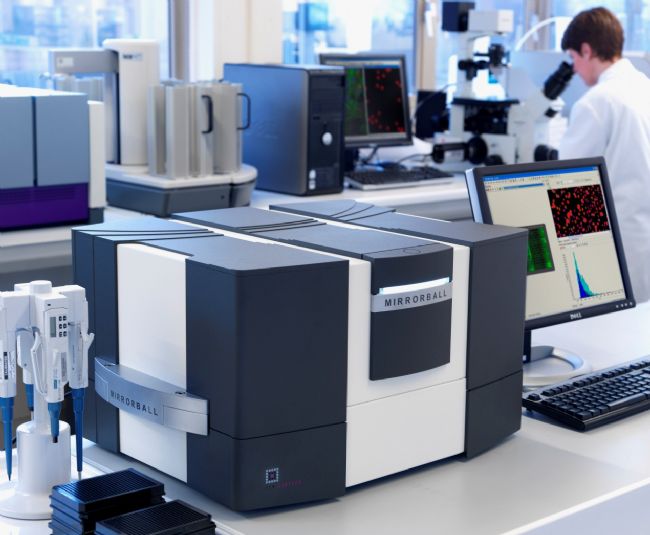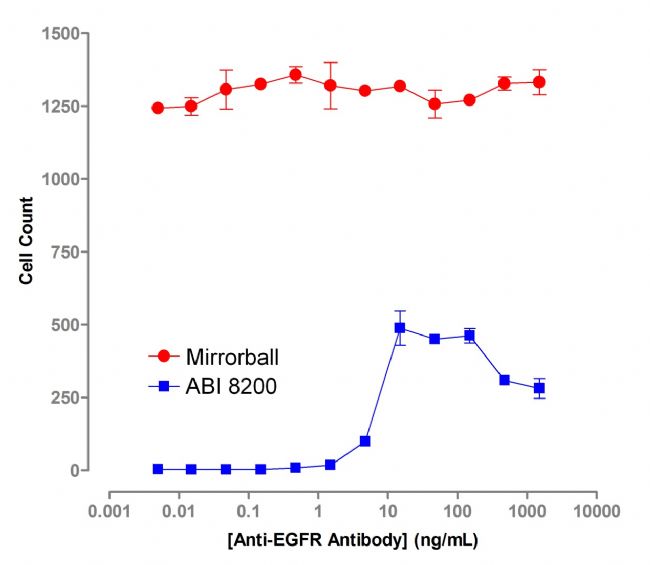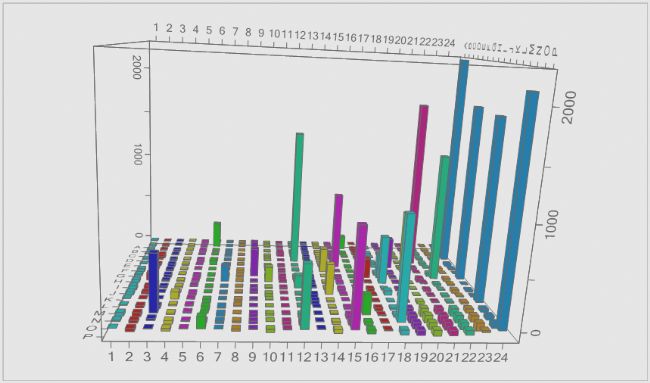An ideal alternative to the ABI 8200 FMAT : "Mixed Read-Only One-Step Detection" mode gives you a new experience in antibody screening that is not used for ELISA and flow cytometry Antibody-based immunoassay applications and related disease treatment areas such as cancer, autoimmune diseases, etc. have been driving research on antibody screening. Monoclonal antibodies are secreted into the supernatant by specific cell lines, and screening for specific antibodies in the supernatant has become a core area of ​​initial drug development. Homogeneous combination experiment Although traditional methods such as ELISA and flow cytometry are widely used, both of these detection methods have their own limitations, especially the detection of low expression antigen on the cell surface. At the same time, these two platforms require cumbersome steps of washing and incubation and take a lot of cells and time to get the data. In order to solve these technical bottlenecks, we have developed Mirrorball, a high-sensitivity detection platform and an experimental scheme of “mixing and reading one-step detectionâ€, which greatly improves the throughput of antibody screening and avoids cumbersome experimental steps. The experiment you need to do is simply add all the reactants to the wells and incubate for a while. Here, the soluble antigen bound to the microsphere may also be an antigen expressed on the surface of the cell. Once the reaction reaches an equilibrium state, the microbead or cell which binds the antibody to be tested can quickly pass the fluorescently labeled secondary antibody. To detect it. Compared to flow-through and traditional ELISA, Mirrorball allows you to perform initial screening of antibody drugs with minimal reagent consumption, minimal time, labor costs, and higher throughput and automated integration compared to a flow-free and conventional ELISA. . I hope to bring you the most simple and efficient antibody screening experience, not suitable for studying expensive and low abundance antigens. Analysis of homogeneous antibody binding assay Mirrorball and another similar product, the ABI 8200 FMAT, are designed with many features for homogeneous combined experiments. By using a laser as an excitation source and a photomultiplier tube as a detection device, this enables them to detect the binding of low affinity antibodies to low abundance antigens. Both systems minimize background fluorescence in the optical path design and greatly increase the signal-to-noise ratio when scanning readings. In this application note, we specifically compared the performance of the two platforms Mirrorball and ABI 8200 for antibody screening by cell-level experiments. By contrast, we demonstrate the multiplexed fluorescence detection capabilities of Mirrorball, which makes it possible to label multiple antigens simultaneously. method Cell line and culture method In this study, Mirrorball and ABI8200 systems were compared in the A431 cell EGFR antibody binding assay. A431 cell Cultured in EMEM (EBSS) (Sigma) containing 10% fetal bovine serum, 2 mM glutamine (Sigma), 1X non-essential amino acids (NEAA) (Sigma) and 100 U / mL penicillin and 100 U / ml streptomycin . A431 cells were cultured to 80% confluency and collected with 0.25% trypsin and EDTA, washed and suspended in the medium. Culture reagents were purchased from Life Technology unless otherwise stated. Antibodies and reagents The antibody, murine anti-human epidermal growth factor antibody (anti-EGFR antibody), was purchased from Merck Chmicals Ltd (#GR01). Goat anti-mouse IgG, AlexaFluor647 (#A21235) was supplied by Life Technologies. CFSE mark 5(6)-Carboxydiacetic acid N-succinimidyl ester (CFSE) (Sigma) was configured to 100 mM in DMSO. CFSE (10 nM) was added to the cells and incubated for 10 minutes at room temperature. The reaction was stopped with 4% FBS in PBS (2 ml). After further incubation, after 10 minutes at 37 ° C, the cells were centrifuged at 1000 xg for 5 minutes. EGFR experiment Anti-EGFR antibodies were serially diluted in medium and 20 ul to 384 well plates (Costar #3712). For the Mirrorball system, suspension of CFSE-labeled A431 cells contained 1 × 10 5 cells/mL and 6 nM anti-mouse IgG AlexaFluor647 secondary antibody. For the ABI 8200 platform, a suspension of A431 cells was prepared containing 4 x 10 5 cells/mL and 6 nM anti-mouse IgG AlexaFluor647. First, 20 uL of a cell suspension mixed with a fluorescent secondary antibody was added to each well and incubated at 37 ° C for 2 hours. Scans were performed on the Mirrorball and ABI8200 platforms, respectively, and the number of cells bound to the EGFR antibody was determined. Finally, the concentrations of Mirrorball and ABI8200 were 2000 cells/well and 8000 cells/well, respectively, and 3 nM antibodies were bound (Figure 1). Figure 1. Schematic representation of Mirrorball epidermal growth factor receptor detection. The experimental protocol of ABI 8200 was essentially identical except that the concentration of A431 added was 4 X 10 5 cells/ml. Mirrorball data scanning and acquisition The microplate was scanned using a designated laser of 488 and 640 nm. The cells in each well will be "on" using TTP LabTech The patented threshold algorithm and two morphological fluorescence parameters were previously reported by Bowen and Methodist (1). Full-well scanning and data visualization in a variety of ways, including histograms or scatter plots, 3D fluorescence intensity distribution, or whole and using Mirrorball's image CellistaTM software. ABI 8200 data scanning and acquisition The sample was scanned using a 640 nm laser. Cell counts and total fluorescence intensity were exported to Excel files and processed as Lee et al (2). The experimental data only collected the area of ​​the area of ​​the hole 1 mm 2 in the center of the hole. Data result To compare the differences in EGFR detection sensitivity between Mirrorball and ABI 8200, A431 cells were incubated with a gradient dilution of EGFR primary antibody and AlexaFluor647-labeled goat anti-mouse IgG secondary antibody. When analyzed with Mirroball, cells were stained with CFSE, cells were pre-localized and counted, and the amount of cells was 2,000 per well in a 384-well plate. For ABI 8200, the A431 cell volume was 8000 inoculation per well. Figure 2 shows that the sensitivity of Mirroball detection is the same as that of ABI 8200. From the concentration of 5 ng / ml anti-EGFR antibody, the fluorescence gradually increases with increasing concentration. Both methods detected a stronger fluorescence reduction at a concentration higher than 100 ng/ml. This is also the reported "hook effect" (2). Here, mainly the excess primary antibody is supersaturated, preventing the binding of the fluorescent secondary antibody and the final experimental reading. Figure 2 Antibody concentration-dependent fluorescence intensity curve of anti-EGFT antibody and A431 cell binding Mirrorball's multi-laser capability provides a unique advantage, and cell recognition is not affected by lower antibody binding. The ABI 8200 is only equipped with a single 640 nm laser, so it can only detect fluorescence above the background. However, when cells were individually stained with CFSE (488 nm) dye when using Mirrorball, cell counting was no longer dependent on binding of fluorescent antibodies (Figure 3). Reliable cell counting also increases the robustness of the data. Figure 3 Mirrorball allows the measurement of CFSE-labeled cells independent of the amount of binding of the fluorescent antibody. On the ABI 8200 platform, cells must have a combination of fluorescent antibodies to be detected. Not only does Mirrorball offer the same high sensitivity as the ABI 8200, but it also scans cells throughout the well and is unaffected by cell distribution compared to the ABI 8200 that can only scan 1 mm 2 (Figure 4). Due to the limited scan area of ​​the ABI 8200, higher cell numbers are often required to obtain more statistically significant results. Figure 4 Comparison of Mirrorball and ABI 8200 scanning areas The use of Mirrorball can greatly reduce the amount of cells in each well, which is especially useful for some cell lines that grow slowly and relatively small, which can save the experimental consumption. Mirrorball's software, Cellista, is able to process data like the ABI 8200 and directly present the location of the hit hole. This feature allows us to work with the experimental data on the previous ABI 8200. The EGFR experiment here is a very straightforward case. You can experiment directly on Mirrorball without changing the existing protocol. Figure 5 uses the average fluorescence intensity of each bead or cell to represent the hit discuss The homogeneous reaction and the “mixed-read one-step test†mode are particularly suitable for biomedical research and development, especially in the high-throughput antibody drug screening phase. Because this mode can reduce the number of washings and incubations and enhance the sensitivity of detection, compared with the traditional ELISA, the experimental time is greatly shortened and the experimental throughput is improved. At the same time, it is more advantageous than instruments such as flow cytometry, and can also reduce the amount of cells and reagents. Here we compare the detection sensitivities of Mirrorball and ABI 8200. The experimental results show that the sensitivity of Mirrorball is also excellent, and the experiments performed on the ABI 8200 can be directly transferred to the Mirrorball. Mirrorball is the first instrument to perform simultaneous multi-laser scanning, correlating different fluorescence at the same time. This feature provides excellent multiplex fluorescence detection when using different fluorescent dyes, especially when applied to antibody screening experiments. This includes the ability to simultaneously detect multiple antigens or simultaneously detect different labeled cell surface antigens (eg, wild-type and transgenic cell lines). Overall, TTP Labtech's Mirrorball microplate cytometer's “mixed-to-read†assay provides the most robust data for the detection of soluble antigens or cell surface antigens. The automated antibody screening technology integrates the mixing-reading method to combine high-sensitivity detection with high-content antibody screening to improve drug screening efficiency. Therefore, Mirrorball is also an ideal replacement for the ABI 8200 and will be the next generation antibody screening platform.
We are manufacturer of Outdoor PTZ Camera in China, if you want to buy Mini Camera , Outdoor Camera,Hidden Wireless Cameras,Camera Cctv With Motion Detection Solar Camera please contact us.
What is solar monitoring?
Outdoor PTZ Camera,Outdoor Camera CCTV HD Security,Full color HD 1080P AI Camera, PTZ Camera Outdoor Network wifi,1080p Night Vision camera Shenzhen Fuvision Electronics Co., Ltd. , https://www.outdoorsolarcameras.com





Fax: 086-21-51821822
mailbox:
LBD Tengquan Beijing Office Room 138, Science Park Road, Zhongguancun Life Science Park, Changping District, Beijing, China Tel: 086-10-56102295
How does the solar surveillance camera work?
Solar powered surveillance cameras use solar panels to harness sunlight and convert it into direct current (DC). The inverter then converts direct current to alternating current (AC), which can then be used to power the solar monitoring.
What happens when it rains or it's cloudy -- can solar surveillance cameras work?
Most solar cameras are also equipped with alternative or backup power supplies, usually rechargeable batteries. The solar panel not only powers the Security Camera, but also charges the battery. When there is no direct sunlight (i.e. at night or in rainy days), the solar powered security camera will be powered by rechargeable batteries. Once there is direct sunlight, the battery will start to charge.
Benefits of Solar Monitoring Cameras
The main advantage of the solar monitoring camera is that the solar panel charges the battery powered camera, creating a renewable power supply. Although a Wi Fi connection is required, these cameras can be used in areas of the home that are difficult to access, such as roofs. For places that are not suitable for using wired security systems, the solar safety monitoring camera provides a reliable choice of security systems without the trouble and additional costs of running cables.
Wireless Solutions
Internal battery charging
Easy to install, no installation cost
Easy to track private property
Scalable solution that can be easily adjusted to meet your future needs - as many solar panels can be added as possible as the camera power
Environmentally friendly
For more information please contact:
LBD Tengquan Headquarters 4th Floor, Building 21, 88 Darwin Road, Zhangjiang Hi-Tech Park, Shanghai, China Tel: 086-21-51088608